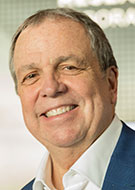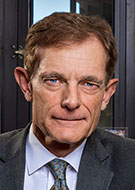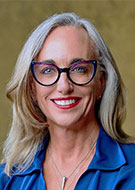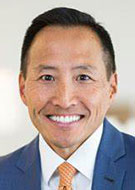From Imaging to Impact: Radiologists in Leadership
Driving change, inspiring teams and shaping health care’s future




This is the second article in a three-part series about the experience of radiologists in leadership. Read the first and third articles in the series.
Academic radiologists in high-level leadership positions are working to transform health care systems today, executing bold initiatives while identifying and mentoring tomorrow’s leaders.
Radiologists who have risen through the vice chair and chair roles to take on larger roles at their institutions are singularly focused on patient-first care. They also share an intellectual curiosity and passion for problem-solving that reaches beyond the radiology department.
“I wanted to have a broader reach and be able to influence more individuals in the health care system,” said Michael D. Dake, MD, who, as senior vice president for health sciences at the University of Arizona in Tucson, oversees six different colleges. “I’m trying to do what I can to really help the institution and I’m thinking about a lasting impact, which requires investment and time.”
As president of Brigham and Women’s Hospital (BWH) in Boston, Giles Boland, MD, is helping to complete the merger of clinical and academic teams at BWH and Massachusetts General.
“We’ve transformed an 82,000-person organization through primarily a belief in doing what’s right for patients,” said Dr. Boland, who is also president of the Brigham and Women’s Physician Group.
Aspiring leaders must understand the broader challenges in medicine, according to Dr. Boland. “You have to think of what your colleagues are going through, from frontline workers to the C-suite,” he said. “It requires continuous learning and a willingness to explore what keeps others up at night.”
On-the-Job Training
Professional development for some leaders is less about skill development and more about on-the-job training.
“Early on in my career, when I was a vice chair and even early years of being a chair, I was much more engaged in issues related to development,” said Cheri Canon, MD, chief physician executive of the University of Alabama at Birmingham (UAB) Health System and president of the UAB Health Services Foundation. “For example, I realized I had a deficit in finance that I had to shore up.”
But one week into Dr. Canon’s current role at UAB, the UAB Health System leadership team entered into a non-disclosure agreement to evaluate the acquisition of another health system, which meant she had to quickly get up to speed on her new teams and responsibilities—and on mergers and acquisitions.
“It’s very much about on-the-job learning, falling back on some of the basic tenets of leadership and tapping into my mentors,” she said.
“As a leader, you must be transparent and consistent, and you must deliver. When you do those things, you will garner trust. People know where you stand.”
— CHERI CANON, MD
Building Trust and Credibility
Earning the trust and credibility to lead large-scale change has been relatively straight-forward according to Dr. Canon. “It’s as simple as putting your head down and doing the work right,” she said. “As a leader, you must be transparent and consistent, and you must deliver. When you do those things, you will garner trust. People know where you stand.”
Robert Min, MD, president and CEO of the Weill Cornell Physician Organization and professor and chair of radiology at Weill Cornell Medicine in New York City, emphasizes the importance of emotional intelligence and clear, impactful communication.
“I really try to put myself in someone else’s position to understand their perspective before I respond,” he said. “If you want to be an effective leader or mentor, you have to learn how to deliver news that people really listen to.”
Dr. Min considers authenticity and integrity critical attributes of a good leader. A common purpose, he said, provides a rallying point. “If the goal is making every patient experience the best it can be, people can get behind that and go above and beyond,” he said.
For Dr. Dake, letting employees know he will support, protect and defend them—and keeping them focused on their primary responsibility of serving the hospital’s constituents—is a powerful combination. “I think that sort of carries the day when people understand why they’re there,” he said.

Navigating Challenges and Driving Change
Today’s health care leaders face mounting challenges, including declining reimbursements, staffing shortages, growing competition, and resistance to change.
Radiology as a specialty is always on the frontier of medical technology and a financial driving force in health care, making leaders from within radiology uniquely poised to lead health systems through these challenges and to define the future of radiology and health care.
“While I embrace change, in my experience, most people do not,” Dr. Canon said. “It’s always a challenge to motivate and drive a large group of individuals to embrace change and move forward with you.”
Dr. Dake believes bold initiatives and calculated risks are essential for meaningful leadership. “You need signature projects to galvanize your team, so they see what the North Star is,” he said. “They need to understand the vision, what it will take and how it will benefit everyone.”
Mentorship: A Cornerstone of Leadership
Mentorship is a priority and a passion for radiologist leaders. It not only strengthens the profession by fostering a culture of collaboration and continuous learning but also plays a pivotal role in shaping a resident’s career through guidance, networking and early exposure to subspecialty opportunities. It also fuels the mentor.
“One of the most fulfilling aspects of my career has been mentoring,” Dr. Canon said. “Seeing others succeed fuels me professionally.”
Dr. Min is such a believer in mentorship and its contribution to employee success that he personally meets with all new hires, including physicians, nurses, technologists and support staff. “It’s one of the most enjoyable parts of my job,” he said. “Employees understand from the moment they join us that they are incredibly valued. I believe that’s critical to driving excellence.”
To foster collaboration and promote support across departments and institutions, Dr. Min uses robust data analytics that track patients as they move through the system to measure downstream financial and non-financial benefits. “I’m a big fan of data,” he said. “Physicians are scientists, and it’s helpful for them to see the numbers. We must co-invest in each other.”
For More Information
Read previous RSNA News articles on radiology leadership in health care: